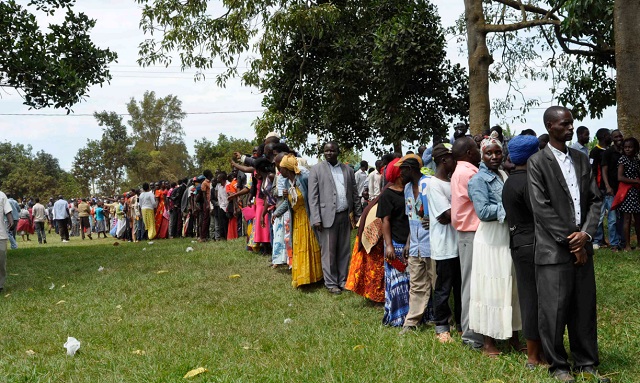
The electoral body wants to clear disputes over names and boundaries
Kampala, Uganda | RONALD MUSOKE | With the women council and committee elections coming up later this year, the Electoral Commission (EC) has begun verifying all administrative units right from the smallest village to Kampala City.
The verification is required before the EC conducts elections for the women councils and committees scheduled for June-August this year and the Local Council I and Local Council II elections scheduled for next year.
According to the National Women’s Council Act 2016, the term of office of the councils and committees is four years. The current members of the women councils and committees were elected between July and August 2018, and the executive committee of the national women’s council was constituted in August, 2018.
Meanwhile, the EC is also undertaking preparatory activities ahead of the LC I and LCII elections scheduled for next year. The term of office of LCI and LCII committees is five years. The current office bearers were elected between July and August 2018 and their terms of office are set to expire during the period of July-August 2023.
The EC says the current verification exercise of administrative areas is necessary because during the conduct of the last women councils and committees and administrative units (LCI and LCII) elections in 2018, the EC noted various disputes over the legal establishment of some of the villages/cells.
Exercise to resolve disputes
Paul Bukenya, the Acting Head of Public Relations at the EC told The Independent on March 15 that the commission intends to ascertain all administrative units countrywide in preparation for the planned electoral exercises.
He said the 2018 elections had several issues of contentions including legality of some villages. “Some stakeholders argued that some villages were not established by a statutory instrument. They said these villages were just created for purposes of elections. Others disputed the names of the villages while others said the villages’ boundaries were not right.”
He added: “Other villages disputed being in particular parishes while some parishes disputed the sub-counties or town councils where they were put.”
“We were frustrated and so what we are doing right now is to go back and verify and confirm that the administrative units that exist on the ground are established by law; that their names are correct and that the boundaries are accurate,” Bukenya said.
“There were disputes over some villages that were located in areas declared by the Uganda Wildlife Authority (UWA) as conservation areas or as forest reserves by the National Forestry Authority (NFA).” This hampered the commission to organise elections in some of the affected areas, he said.
According to the EC database, there are 146 districts and cities, 2,211 sub-counties, towns and municipal divisions, 431 wards in the cities, 10,259 parishes and wards in the districts and 70,512 villages or cells.
The EC is mandated to ensure that all administrative units have their respective councils and committees. However, the councils and committees (women and LCI and LCII) can only be established in accordance with the existing administrative units.
The EC says it is critical to establish the actual locations and numbers of administrative units for which the above elections are to be held in compliance with Section 7 and 45 of the Local Governments Act, (Cap 243).
The purpose of the verification exercise is to confirm that the existing administrative units have been legally created, that is, by statutory instrument. It is also meant to confirm that the administrative units are correctly located within their respectful and rightful sub-county/town council/municipal division and parish/ward.
The EC says it needed to confirm that all administrative units’ names as listed, that is, district, constituency, sub-county/town council/municipal division, parish/ward and village/cell are correctly spelt and written. There is also need to identify and harmonize any variance in the database of administrative units.
Process of administrative units’ verification
Bukenya told The Independent that the EC does not create villages and as such works with the technical teams established by the Local Government Act. These include; Senior Assistant Secretaries or the town clerks and sub-county supervisors of the respective local government.
The senior assistant secretary/town clerk and electoral commission sub-county supervisor ensure that all administrative units’ names (district, constituency, sub-county/town/municipal division, parish/ward and villages) are correctly spelt.
They then ensure that all administrative units are placed in their rightful locations (district, constituency, sub-county/town/municipal division and parish/ward).
They also confirm the names of villages by ticking against each village on the list; and indicate on verification form any objections against inclusion or exclusion of any village and parish. In case of inconsistencies between the village which is on the EC list and the list submitted by the district authorities, confirmation of creation or removal should be attached.
Once field verification is completed, the sub-county supervisors deliver the verified list to the Chief Administrative Officers (CAO), District Planners and Returning Officers for confirmation.
Then, the CAO, District Planner and Returning Officer forward the confirmed list to the Secretary, EC, accompanied with a letter bearing their signatures. The confirmed administrative units, verification lists and forms shall then be received and submitted to the EC.
It is at this point that the EC verifies and processes lists of administrative units including all confirmed changes. The verified list of administrative units shall then be printed and displayed at both the district/city and sub-county headquarters to ensure accuracy and to allow any stakeholders who may wish to raise any objections against inclusion or omission of administrative units to do so, for hearing and determination.
Any objections against inclusion or omission of an administrative unit are then raised to the District Returning Officer through the Sub-County Supervisor using Administrative Unit verification form.
At the end of the display of administrative unit exercise, the returns are received at the EC, processed and a cleaned list issued to relevant stakeholders.
According to the EC, the public benefits directly from the verification exercise because the administrative units inform the basis for their representation at the local government. The public, therefore, has a role in ensuring that correct data is recorded.
“The public is urged to turn up during the display which will take place from April 11-20, this year at the district/city and sub-county headquarters and scrutinize the verified list of administrative units to ensure accuracy of the data,” Justice Simon Byabakama said in a Feb.28 statement.
If there are no objections from the public, the EC will process the verification returns and produce final lists of administrative units which will be disseminated to stakeholders by May 13.
Bukenya told The Independent that the verification exercise is very important because when you have a participatory approach to resolving issues; it gives you some assurance that when the EC starts conducting the elections, it will be smooth and you will not have challenges.
“We know that out of these disputes; some issues have ended up going to the High Court resulting into huge costs and time while citizens have ended up not being represented.” Bukenya told The Independent, adding that a village remains a very a good administrative unit where political parties do mobilization while a parish provides a basis for registration of voters nationwide.
He said government agencies like the National Identification and Registration Authority (NIRA) also use this information for their work while actors like civil society organizations prefer working with legally established units.
“The verification exercise will even come in handy now that there is the Parish Development Model where local government statistics are going to play a critical role in implementing the programme,” Bukenya told The Independent.
****
 The Independent Uganda: You get the Truth we Pay the Price
The Independent Uganda: You get the Truth we Pay the Price



